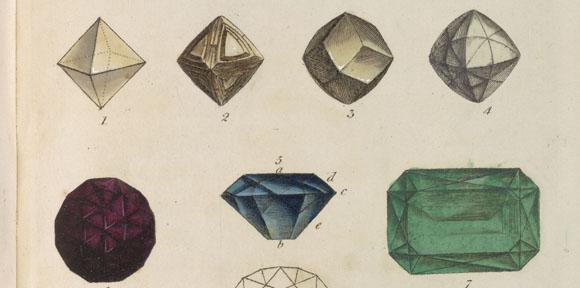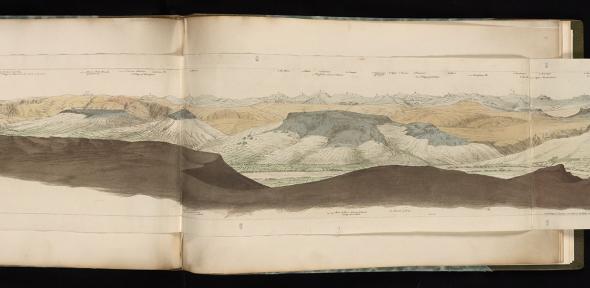Clik here to view.

Uncovering how the ground beneath our feet was mapped for the first time – and revealing some of the controversies and tragedies geology brought to the surface of intellectual debate, Landscapes Below opens to the public on Friday, November 24, at Cambridge University Library.
Featuring the biggest-ever object (1.9mx1.6m) to go on display at the Library: George Bellas Greenough’s 1819 A Geological Map of England and Wales (the first map produced by the Geological Society of London), as well as a visually stunning collection of maps from the earliest days of geology – the exhibition explores how these new subterranean visions of the British landscape influenced our understanding of the Earth. All the maps belonging to the library are going on display for the first time.
“I think the maps are beautiful objects, tell fascinating stories and frame geology in a new light,” said exhibition curator Allison Ksiazkiewicz. “This was a new take on nature and a new way of thinking about the landscape for those interested in nature.
“We show how the early pioneers of this new science wrestled with the ideas of a visual vocabulary – and how for the first time people were encouraged to think about the secretive world beneath their feet.”
As well as maps, Landscapes Below also brings together an extraordinary collection of fossils, artworks and a collection of 154 diamonds, on loan from the Sedgwick Museum of Earth Sciences. Displayed together for the first time, the diamonds were collected, arranged, and produced by Jacques Louis, Comte de Bournon who later became the Keeper of the Royal Mineral Collection for King Louis XVIII.
Another important exhibit on display for the first time is the first edition of George Cuvier and Alexandre Brongniart’s Researches on the Fossil Bones of Quadrupeds (1811), on loan from Trinity College. It examined the geology of the Paris Basin and revolutionised what was considered ‘young’ in geological terms.
Artists were also keen to accurately depict the geological landscape. After surviving Captain Cook’s ill-fated third voyage of discovery, artist, John Webber returned to England and travelled around the country painting landscapes and geological formations, as seen in Landscape of Rocks in Derbyshire. Christopher Packe’s A New Philosophico-Chorographical Chart of East-Kent (1743), on loan from the Geological Society of London, is a remarkable, engraved map that draws on early modern medicine in the interpretation of the surrounding landscape.
“The objects we’re putting on display show the many different applications of geological knowledge,” added Ksiazkiewicz. “Whether it’s a map showing the coal fields of Lancashire in the 1830s – or revealing how this new science was used for economic and military reasons.”
In many ways, the landscapes the earliest geologists worked among became battlegrounds as a scientific old guard – loyal to the established pursuits of mineralogy and chemistry – opposed a new generation of scientists intent on using the fossil record in the study of the Earth’s age and formation.
Exhibitions Officer Chris Burgess said: “Maps were central to the development of geology but disagreement between its leading figures was common. Maps of the period did not just show new knowledge but represented visible arguments about how that knowledge should be recorded.”
The exhibition also includes objects from those with rather tragic histories, including William Smith – whose famous 1815 Geological Map of England has been described as the ‘Magna Carta of geology’. Despite publishing the world’s first geological map (which is still used as the basis of such maps today), Smith was shunned by the scientific community for many years, became a bankrupt, and ended up in debtors’ prison.
John MacCulloch, who produced the Geological Map of Scotland, did not live to see his work published after his honeymoon carriage overturned and killed him at the age of 61. He spent 15 summers surveying Scotland, after convincing the Board of Ordnance to sponsor the project. There was some dispute about how MacCulloch calculated his mileage and spent the funds, and the Ordnance only paid for six summers’ worth of work. Five summers were paid for by the Treasury and four from his own pocket.
Added Ksiazkiewicz: “Not only do these maps and objects represent years of work by individuals looking to develop a new science of the Earth, they stir the imagination. You can imagine yourself walking across the landscape and absorbing all that comes with it – views, antiquities, fossils, and vegetation. And weather, there’s always weather.”
Landscapes Below runs from November 25, 2017 to March 29, 2018 at Cambridge University Library’s Milstein Exhibition Centre. Admission is free. Opening times are Mon-Fri 9am-6pm and Saturday 9am-16.30pm. Closed Sundays.
A box full of diamonds, volcanic rock from Mount Vesuvius, and the geology guide that Darwin packed for his epic voyage on the Beagle will go on display in Cambridge this week as part of the first major exhibition to celebrate geological map-making.
Image may be NSFW.
Clik here to view.
The text in this work is licensed under a Creative Commons Attribution 4.0 International License. For image use please see separate credits above.




